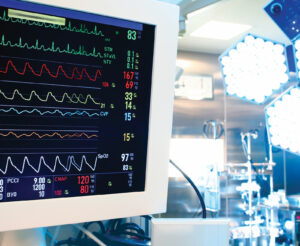“The Anesthesia Patient Safety Foundation believes that anesthesia professionals should be competent to use advanced medical technology to provide safe patient care.”
—APSF Newsletter, Winter 2013.
 The APSF has recognized for many years that understanding how to use medical technology is fundamental to patient safety.1 In an effort to promote that understanding, APSF is pleased to announce a new educational program on the use of medical technology. APSF has partnered with the University of Florida Center for Safety, Simulation and Advanced Learning Technologies under the direction of Sem Lampotang, PhD, to develop a web-based educational program. This program will be available to all anesthesia professionals and requires only an internet connection and web browser to access the content. Continuing education credits are intended to be offered.
The APSF has recognized for many years that understanding how to use medical technology is fundamental to patient safety.1 In an effort to promote that understanding, APSF is pleased to announce a new educational program on the use of medical technology. APSF has partnered with the University of Florida Center for Safety, Simulation and Advanced Learning Technologies under the direction of Sem Lampotang, PhD, to develop a web-based educational program. This program will be available to all anesthesia professionals and requires only an internet connection and web browser to access the content. Continuing education credits are intended to be offered.
Two topics have been chosen for the initial educational offerings—Low-Flow Anesthesia and Quantitative Neuromuscular Transmission Monitoring. The recognition that inhaled anesthetic agents are greenhouse gases that contribute to global warming has created a growing interest in the practice of Low-Flow Anesthesia. While the technique can be safely and effectively practiced, there are patient safety implications. The goal of the Low-Flow education is to empower anesthesia professionals with the knowledge required to safely, effectively, and comfortably reduce fresh gas flow and the environmental impact of their practice. Neuromuscular blockade monitoring has long been considered essential to safe patient care when administering muscle relaxants.2
Technology for neuromuscular transmission monitoring continues to advance and this educational program will help the practitioner develop an understanding of the latest technologies and their potential to enhance the safe use of muscle relaxants.
APSF has engaged with several companies who manufacture technologies relevant to these educational topics. APSF does not, however, promote any particular device or manufacturer. The educational content will be device agnostic. APSF will allow links to educational content on company websites that are device specific. This should facilitate access for users to device specific knowledge. APSF will not, however, have any responsibility for the content presented through those industry web links.
Look for the details of this exciting program in the October issue of the 2022 APSF Newsletter.
Jeffrey Feldman, MD, MSE is chair, APSF Committee on Technology and professor of clinical anesthesiology at Children’s Hospital of Philadelphia Perelman School of Medicine
Samsun Lampotang, PhD, FSSH, FAIMBE, holds the JS Gravenstein Professorship of Anesthesiology, and is director, CSSALT and Innovations Director, Office of Medical Education at the University of Florida College of Medicine.
Jeffrey Feldman, MD, is a consultant for Medtronic, Becton-Dickinson, and Micropore. Samsun Lampotang, PhD, has no conflicts of interest.
References
- APSF Committee on Technology. Training anesthesia professionals to use advanced medical technology. APSF Newsletter. 2013;27:50–51. https://www.apsf.org/article/training-anesthesia-professionals-to-use-advanced-medical-technology/ Accessed April 16, 2022.
- Murphy G. Residual neuromuscular blockade: a continuing patient safety issue. APSF Newsletter. 2020;35:94–95. https://www.apsf.org/article/residual-neuromuscular-blockade-a-continuing-patient-safety-issue/ Accessed April 16, 2022.


 Issue PDF
Issue PDF PDF
PDF